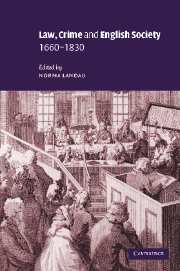Book contents
- Frontmatter
- Contents
- List of figures
- Notes of contributors
- 1 Introduction
- Part 1 Law
- Part 2 Crime
- 5 War as a judicial resource. Press gangs and prosecution rates, 1740–1830
- 6 Making the ‘bloody code’? Forgery legislation in eighteenth-century England
- 7 Mapping criminal law: Blackstone and the categories of English jurisprudence
- Part 3 Society
- John M. Beattie's publications
- Index
7 - Mapping criminal law: Blackstone and the categories of English jurisprudence
from Part 2 - Crime
Published online by Cambridge University Press: 30 June 2009
- Frontmatter
- Contents
- List of figures
- Notes of contributors
- 1 Introduction
- Part 1 Law
- Part 2 Crime
- 5 War as a judicial resource. Press gangs and prosecution rates, 1740–1830
- 6 Making the ‘bloody code’? Forgery legislation in eighteenth-century England
- 7 Mapping criminal law: Blackstone and the categories of English jurisprudence
- Part 3 Society
- John M. Beattie's publications
- Index
Summary
The map of English law
John Beattie's contributions to the historical study of crime and criminal justice have been so formative and so distinguished that it seems almost presumptuous for someone not engaged in this specific field of inquiry to attempt any characterization of his achievement. Still, for the purposes of this chapter it is useful to observe some of the important general lessons of his researches for understanding legal change in eighteenth-century England. Beattie himself concluded his magisterial account of Crime and the courts in England by emphasizing the prominence of this particular theme. During the period 1660–1800 ‘significant changes’ occurred throughout England's system of criminal justice – ‘in the criminal law, in criminal procedure, in prisons, and in punishment’ – and cumulatively these ‘transformed the system of judicial administration’. Interpreting this transformation required not only the historical recovery of patterns of crime and their prosecution, but even more a reconstruction of the technical administrative structures and legal processes through which the criminal law was enforced. The transformation of criminal justice, as charted by Beattie, did not occur without public debate and controversy; and on infrequent occasion, as in the case of the 1718 Transportation Act, it depended critically on parliamentary intervention. But in contrast to the more immediately visible statutory law reforms of the Victorian era, legal change in the eighteenth century rarely involved any direct or sweeping dismantling of historical practices and forms.
- Type
- Chapter
- Information
- Law, Crime and English Society, 1660–1830 , pp. 139 - 162Publisher: Cambridge University PressPrint publication year: 2002
- 1
- Cited by



